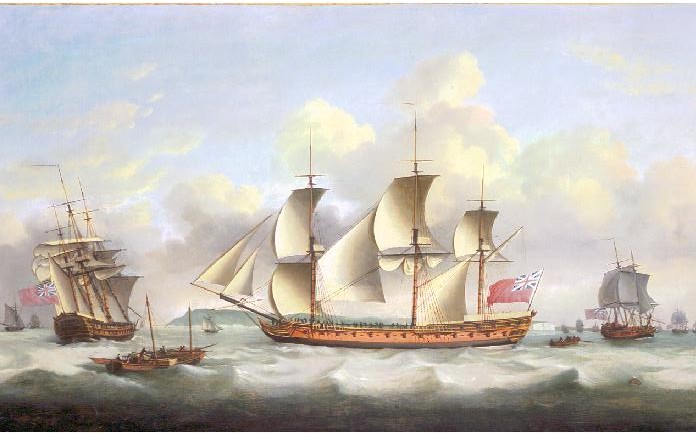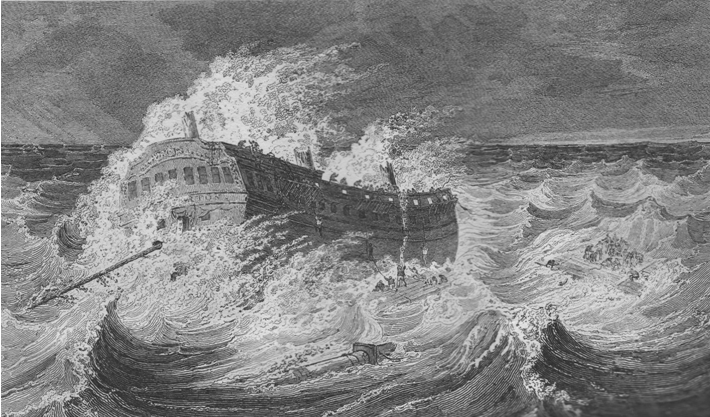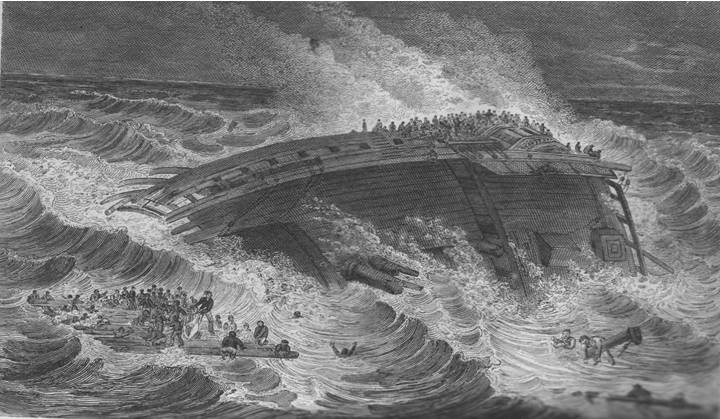|
|
Hardback
published 2003 by Conway 288 pages
ISBN 0-85177-941-7
|
|
|
|

|
| The HEICS Winterton by Thomas Luny (c) Colin Denny |
Marked for Misfortune
was my first maritime book, and I was incredibly lucky that nobody else seemed to have come across the story in any detail.
It began back in about 1985 with a painting by the 18th Century maritime artist Thomas Luny, owned by a London
art dealer who wanted to know if the subject, the Honourable East India Company’s ship Winterton had any history.
It certainly did, but it took a very long time to track it down. Winterton set sail for
India in May 1792, bound for Madras and Bengal. As well as a crew of over 100, she carried army recruits for the 75th
Regiment, under the command of Lieutenant Henry Quinn Brownrigg, and male and female passengers. In all, there were more than
300 people, and they enjoyed a relatively comfortable voyage until August 20th when, in the early hours of the
morning, the ship struck a reef off the SW coast of Madagascar and, having defied all attempts to get her off, went
to pieces.

|
| From "The Loss of the Winterton", George Buchan, 1820, Author's Collection |
What followed was an epic ordeal of sickness and death for the 260 or so who somehow got to land
and came under the protection of the local ruler. Early on, however, the Third Mate, John Dale, took a small group of volunteers
and sailed an open boat to Portuguese East Africa to try to bring help. They suffered hardship and deaths, and even when their
task was achieved the adventure was far from over. War with France had broken out; the Indian Ocean was being searched by
French privateers from Mauritius. It would take a gun battle with a Dutch East Indiaman, an encounter with a French fleet
and an unwanted trip to America before John Dale returned home as a hero. Resources for the book
turned up in archives across the world. Much of the research was done before the time of the Internet, so there were no short
cuts to be taken, and every time I thought I had got the story straight it threw up another twist. The last big discovery
came a couple of years ago when I was approached by a the production company making the Who Do You
Think You Are? series for the BBC. One of the passengers on the ship went by the name of Suetonius
McGowan, and it turned out that his direct descendent is the British actor and impressionist Alastair MacGowan.
The sister who was with him on the Winterton and who drowned was named Jessie. Research
never ends.
In 2011 I was told that another of the passengers, Mary Bristow, married
an officer in the Bengal Engineers, James Tillyer Blunt on 3/9/1796. Mary and her sister Charlotte were the daughters
of a very wealthy merchant, John Bristow, and his Indian mistress.

|
| From "The Loss of the Winterton", George Buchan, 1820, Author's Collection |
Extract:
"To the limits of the dark horizon the sea shone satin beneath the brilliance of a starlit tropical sky, reflecting the
moon in a rippling strake of gold. From the quarterdeck of the Winterton, his nightglass lowered, John Dale glanced
at the helmsman to check he still held the ship on her course. The broad, bluff bow rose and fell in its satisfying rhythm,
parting the dark water with a deep and heavy plash that no longer disturbed the sleep of the passengers in their stuffy cabins
below. Rope and timber groaned and flexed as they restrained the canvas against the south-southeasterly wind, holding
the big East Indiaman to a prudent 6 knots. So familiar were the sounds that the absence of footsteps and voices gave an illusion
of silence. Dale raised the nightglass to his eye once again and scanned the eastern horizon. Nothing. No breakers to
warn of rocks; no fires to indicate coastal settlements. Nineteen days out of False Bay, Winterton was heading ENE up
the Mozambique Channel between the coasts of East Africa and the island of Madagascar, bound for Bengal. A perfect night under
the new moon: no cause for any more concern than a conscientious Third Officer ought to feel when left in charge of one of
the world’s finest merchant ships, a cargo worth over £100,000 and the lives of nearly 300 souls. Nevertheless,
Dale was anxious. The light wind brought a smell of land to his nose, sapping his confidence in their position…”
Reviews: ‘Superbly researched…An astonishing story which often
reads more like a novel than a work of non-fiction…As an example of how sources can be used to paint a vivid picture
of the past, this book is an example to all.’ - The
Review, quarterly journal of the Naval Historical Collectors & Research Association ‘Through her considerable writing
ability it is a story which also grips the reader.’ -
Greenwich Maritime Institute ‘…careful and well-researched…This is an excellent read.’
- South West Maritime History Association ‘An extremely well told factual
account, which would not have been out of place had it been recalled in a Hornblower novel.’ - Cruising Association
|

